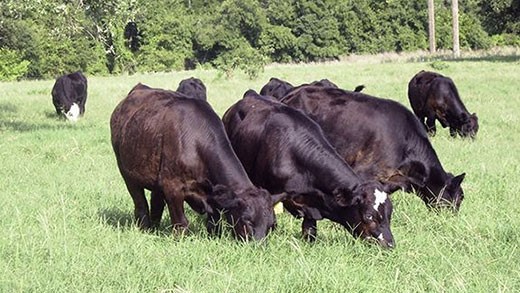Kansas State beef veterinarian outlines warning signs and preventive steps.
June 15, 2018

The hot summer weather and potential for lots of sunlight may also bring a cause for concern among livestock producers. Those conditions, combined with the often stagnant nature of farm ponds, heighten the risk of toxic levels of blue-green algae in producers’ watering sources, according to Kansas State University beef veterinarian A.J. Tarpoff.
“It surely can be a devastating condition,” Tarpoff said. “There are very specific species (of bacteria) that, whenever they flourish in a pond, they release these toxins that are lethal to all animals.”
Blue-green algae is actually not an algae at all, he noted, but a cyanobacteria — bacteria that live off the sun. They can be toxic to livestock, dogs and people. “These are pretty nasty organisms,” Tarpoff noted.
Blooms of cyanobacteria can build up in a pond and form into distinct blooms of bacteria that often look like paint swirling around on the water. Tarpoff said the paint-like texture of cyanobacteria is what differentiates it from non-harmful moss in a pond.
The harmful cyanobacteria can look green or dark green but can turn more to a bluish tint, thus leading to its more common name as blue-green algae.
“It can go from blue to green to almost a reddish-brown or gray,” Tarpoff said. “We can have all of those color variations, but just remember that it looks a lot like paint mixing with water. That’s what it looks like floating around.”
Cyanobacteria can release two types of toxins: neurotoxins, which affect an animals’ nervous system, and hepatotoxins, which affect the liver function of cattle. Both toxins can cause death, which sometimes is the first signal to producers that they have a problem with their watering source, according to Tarpoff.
He added that producers who suspect that blue-green algae is in their ponds should immediately get the water tested, which involves capturing about 500 mL of water in a sealed container, refrigerating that sample and shipping it with an ice pack to a testing facility.
The Kansas State Veterinary Diagnostic Lab in Manhattan, Kan., is one such laboratory that conducts testing for cyanobacteria. Tarpoff noted that sending multiple samples from the pond is one way to capture a reliable picture of the pond.
If a producer suspects that a pond contains dangerous levels of cyanobacteria, it’s important to keep livestock and people out of the area. Cyanobacteria is known to form on the downwind side of the pond, so one good practice is to fence off that side of the pond.
Producers may be able to use the available water in a suspect pond by piping water from less harmful areas of the pond. Blue-green algae blooms are not known to collect in the middle of water sources, Tarpoff said.
“What’s important, if you’re going to do an upgrade like that, is the water inlet,” Tarpoff said. “We want the water inlet to be in a lower-risk area of the pond, which means it is submerged and in the middle of the pond.”
Other watering options for producers might be digging a well or hauling water all summer. Tarpoff noted, though, that both of those options could be cost prohibitive.
During hot stretches, it’s especially important to be aware of cyanobacteria and to monitor ponds daily, he said.
“These blooms can pop up pretty quickly,” Tarpoff said. “The number of cyanobacteria can double in less than 24 hours. If you think you have an at-risk pond, then start to sample right away, send those off to the lab and try to get a realistic expectation of whether it’s at risk or not.”
You May Also Like

.png?width=300&auto=webp&quality=80&disable=upscale)

